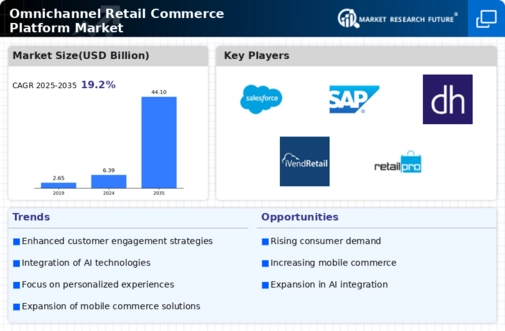The Omnichannel Retail Commerce Platform market is expanding as a result of considerable research and development efforts by key industry players to diversify their product lines. Contracts, mergers and acquisitions, increased investments, and collaboration with other organizations are examples of significant market changes. Furthermore, important industry players are exploring a variety of strategies to expand their international presence. To expand and thrive in a tougher and more competitive market environment, the Omnichannel Retail Commerce Platform firm must deliver services at reasonable pricing.
One of the key ways organizations utilize to service customers and expand the market sector in the Omnichannel Retail Commerce Platform market is local manufacturing to reduce operating costs. The apparel & footwear industry has recently received significant benefits from the Omnichannel Retail Commerce Platform market. Major corporations in the Omnichannel Retail Commerce Platform market, including Cognizant Technology Solutions Corp (US), NCR Corporation (US), IBM Corporation (US), Diebold Nixdorf AG (Germany), Infosys Ltd (India), and others, are trying to surge market demand by spending on research and development processes.
International Business Machines Corporation (IBM) is a company that sells and services information technology (IT). The firm manufactures and sells system hardware and software, as well as providing infrastructure, hosting, and consulting services. Analytics, artificial intelligence (AI), automation, blockchain, cloud computing, IT infrastructure, cybersecurity, and software development solutions are all part of IBM's product range. Cloud, networking, security, technology consulting, application services, and technology support services are all available from the organization.
Its clients include the automotive, banking and financial markets, electronics, energy and utilities, healthcare, insurance, manufacturing, metals and mining, retail and consumer products, and telecommunications industries. The firm operates in the Americas, Europe, the Middle East, Africa, and Asia-Pacific. IBM is headquartered in Armonk, New York, in the United States. IBM Corporation announced a collaboration with Pandora in June 2021 to modernize Pandora's omnichannel e-commerce capabilities using IBM sterling supply chain software.
Oracle Corporation (Oracle) is a provider of cloud-based enterprise solutions. Database and middleware software, application software, cloud infrastructure software, and hardware solutions are all available from the company. It also provides cloud solutions that are interconnected, such as Infrastructure-as-a-Service (IaaS) and Software-as-a-Service (SaaS). Oracle licenses new on-premises software, upgrades licenses, and provides related support solutions. The company sells its products through a network of independent software and hardware vendors, system integrators, and resellers. Hardware, servers, storage, networking, and industry-specific products, as well as related support and services, are available on-premises.
The business operates in the Americas, Europe, the Middle East, and Asia-Pacific. Oracle is headquartered in Austin, Texas, in the United States. Oracle Corporation introduced the launch of the Oracle Retail Xstore office cloud service in January 2019 in order to maintain its momentum in facilitating digital transformation in the retail world.
















Leave a Comment